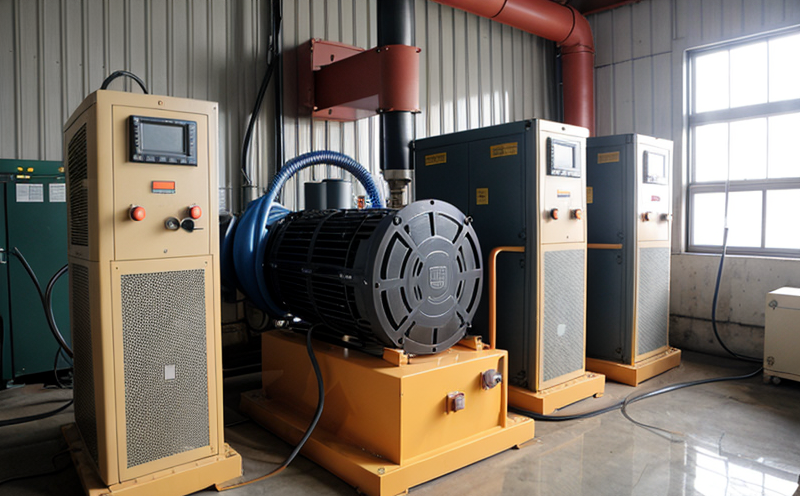IEEE 112 Motor Testing Methods in Power Generation
The IEEE Standard 112 is a comprehensive guide that focuses on the measurement of no-load and locked-rotor characteristics of induction motors. This standard is essential for ensuring the accurate and consistent evaluation of these motors across various applications, particularly within the power generation sector where precision and reliability are paramount.
When it comes to power generation equipment, motors play a critical role in driving turbines and other machinery that convert thermal energy into electrical energy. The performance of these motors directly influences the efficiency of the entire power generation process. By adhering to IEEE 112 testing methods, manufacturers can ensure their products meet stringent international standards, thereby enhancing trustworthiness and marketability.
The IEEE 112 methodology involves several key steps that are designed to yield precise and reliable results. These include the use of specialized test equipment such as wattmeters, ammeters, voltmeters, and power factor meters. The specimens under test must be properly prepared according to specified procedures outlined in the standard.
One critical aspect of IEEE 112 testing is its emphasis on environmental factors that can affect motor performance. For instance, temperature variations during testing can significantly influence the accuracy of no-load and locked-rotor torque measurements. Therefore, controlled environmental conditions are crucial to ensure consistent test results across different climates and operational environments.
The standard also provides guidance on interpreting the data obtained from these tests. This interpretation is vital for identifying any discrepancies that may indicate potential issues with the motor's design or manufacturing process. By using advanced analytical techniques, engineers can pinpoint specific areas requiring improvement, leading to better-performing motors and ultimately more efficient power generation.
In addition to its technical merits, IEEE 112 testing contributes positively to environmental sustainability by promoting energy efficiency. More efficient motors consume less electricity while producing the same amount of mechanical output, which translates into lower greenhouse gas emissions and reduced operational costs for power plants and other facilities relying on them.
- Enhanced Energy Efficiency: By ensuring that motors operate at optimal levels, IEEE 112 testing helps reduce overall energy consumption, contributing to global efforts towards reducing carbon footprints.
- Environmental Compliance: Adherence to this standard ensures compliance with local and international environmental regulations aimed at minimizing pollution from industrial processes.
- Resource Conservation: Efficient motors require fewer raw materials during their production phase, thus conserving natural resources such as metals used in motor construction.
Why It Matters
Implementing IEEE 112 testing methods is crucial for several reasons. Firstly, it ensures that power generation equipment operates within specified performance limits, thereby enhancing reliability and safety of the entire system. Secondly, compliance with these standards fosters trust among consumers who rely on consistent quality from suppliers. Lastly, meeting such rigorous testing criteria can help manufacturers gain competitive advantages by differentiating their products in terms of quality assurance.
From a broader perspective, widespread adoption of IEEE 112 testing practices contributes significantly to the overall efficiency of global power generation infrastructure. As power demands continue to grow, maintaining high standards for motor performance becomes increasingly important. Efficient motors contribute positively towards reducing energy waste and promoting sustainable development goals worldwide.
For quality managers and compliance officers, adherence to IEEE 112 provides clear guidelines on how best to implement robust testing protocols. R&D engineers benefit from having precise tools at their disposal for continuous improvement of existing designs. Meanwhile, procurement departments gain assurance that they are acquiring reliable components meeting international benchmarks.
Ultimately, embracing IEEE 112 motor testing methods not only bolsters individual organizations but also supports broader societal goals related to sustainability and responsible resource management within the power generation industry.
Scope and Methodology
The scope of IEEE Standard 112 covers the measurement techniques used for determining no-load and locked-rotor characteristics of induction motors. These measurements are critical in assessing motor performance under various operating conditions, particularly relevant to power generation applications.
According to the standard, testing should be conducted using appropriate instrumentation that includes wattmeters, ammeters, voltmeters, and power factor meters. The specimens for testing must be prepared according to specified procedures outlined in the document. This preparation ensures accurate measurement of both no-load and locked-rotor torque values.
The methodology involves connecting the motor to a suitable load or electrical circuit designed to replicate real-world operating scenarios as closely as possible. During this process, various parameters such as voltage, current, frequency, and temperature are carefully monitored and recorded.
Once all necessary data points have been gathered, they undergo rigorous analysis aimed at identifying any deviations from expected performance levels. Any discrepancies detected during these analyses could indicate potential issues with the motor's design or manufacturing process. Engineers can then use this information to make informed decisions about necessary modifications or improvements.





